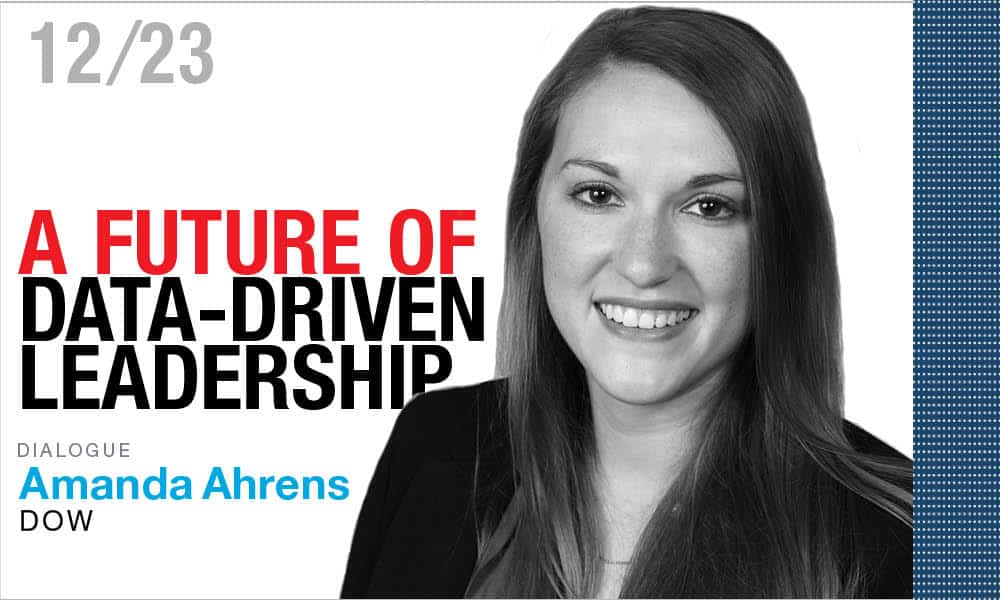Dialogue: A Future of Data-Driven Leadership

With expertise in data science, Dow’s Amanda Ahrens has a unique understanding into what the power of data can mean for the future of manufacturing and its role within R&D, sustainability, asset optimization and more.

Last June, Amanda Ahrens of Dow was honored at the Manufacturing Leadership Awards as the winner of the Next-Generation Leadership category, which is given to a high-performing emerging leader aged 30 or younger. Her background in mathematics and data science is emblematic of the emerging role of data analytics in manufacturing – a true embodiment of the industry’s future.
Ahrens has experience with both corporate IT and R&D during her time at Dow, an unusual and challenging career path but one that gives her unique insight into different areas of the business. She is also a strong advocate for promoting STEM career for women and minorities, serving as a volunteer for the Michigan Council of Women in Technology, computer science coordinator for Dow’s Girls in STEM program, and a coordinator and lecturer for an introductory data science programs for HBCU undergraduates. In this interview, she discusses data’s growing role in manufacturing, how it can provide fuel for ESG initiatives, and what she thinks are the most exciting use cases for AI.
Q: Data science has a growing and important role in manufacturing. How do you see that role evolving in the next 3-5 years?
A: It is becoming easier to access data to build models, deploy models, and maintain models. Data quality, however, has always been and continues to be a barrier to building models that provide useful results. As manufacturers see a return on investment regarding data science, if reinvested to maintain high-quality data (by sharing the results with data owners, investing in soft sensors and AI enhanced sensors, investing in systems fit for purpose that enable fast and easy data cleansing and analysis), other use cases will be unlocked. AI and data science is best when people don’t even realize it is there and will need to be embedded into modern processes and tools to realize the full value cases.
Q: You started at Dow as part of the corporate IT team before making the switch to R&D. What was that transition like for you, and how does data analytics play a role in R&D?
A: My internal clients were completely different in corporate IT, R&D, and Manufacturing regarding what data they regularly worked with, how they used data, and how they wanted to receive data and data analysis. During my transition, I learned about my new client personas. In R&D, data analysis is used to design experiments, analyze lab test results, identify product portfolio gaps for new product opportunities, predict formulations to deliver desired properties, and many other use cases. The data in R&D is very wide, meaning that there are fewer rows (or samples) than columns (chemical structure, properties, applications testing results). Wide data requires data analysis techniques that are meant for this type of data.

“AI and data science is best when people don’t even realize it is there and will need to be embedded into modern processes and tools to realize the full value cases.”
Q: Your role has evolved to include ESG initiatives, working toward the goal of reducing Dow’s carbon emissions. How can manufacturers use data to further their sustainability goals?
A: Having granular, frequent, and accurate data on direct air, waste, and water emissions as well as energy consumption allows for prioritization of capital investment for sustainability initiatives. Tracking raw materials or feedstock with sustainability attributes through procurement, production, material movements, and product sale in a streamlined way enables tracking for product certification and scale to progress on both circular economy and climate goals. Data from suppliers can help you strategically source to lower Scope 2 and Scope 3 emissions and purchase energy, feedstock, and raw materials with sustainability attributes in alignment to your sustainability goals. Data from customers can help you understand your downstream Scope 3 emissions, develop products that better meet their needs and their sustainability goals, and progress on your sustainability goals in the process. The few examples above illustrate that data from your own operations, suppliers, and customers is foundational to decision-making to advance sustainability goals.
Q: It was noted in your awards nomination that you are one of the leaders for Dow’s annual Data Science Challenge. Can you describe that program?
A: Dow has a biannual Data Science Challenge, and I co-led the 2022 Data Science Challenge. Each challenge is run in a shark-tank like format where cross-functional and cross-business teams pitch their data science idea to a panel of Dow executives (sharks). The winning project ideas are then invested in. In 2022, the theme was advancing Dow’s sustainability goals regarding climate, circular materials, and safer materials. The winning idea and other challenge ideas have been incorporated into our digital strategy.

“Girls who are exposed to women in manufacturing will grow up knowing that it is a possibility for them. Women seeing women thriving in manufacturing will attract more to the industry.”
Q: You also have experience with testing AI use cases for Dow. While a number of manufacturers are using AI for quality and preventative/predictive maintenance, what are some emerging use cases that you think have potential for greater impact?
A: A lot of data is unstructured (text) and stored in various systems, emails, PDFs, Word files, Power Point slides, etc. With large language models, like ChatGPT, we can make better use of this collective knowledge to answer procedure questions faster. Soft sensors and sensors that are enhanced or augmented with AI will enable us to gather data that used to be more costly to gather with traditional instrumentation and metering. Having more granular data on emissions, water, and energy from these types of sensors enables optimization of manufacturing processes further regarding energy efficiency, emissions, water conservation, etc., with the use of AI, in addition to optimizing asset utilization. AI could also be used to aid in shut down and start up activities.
Q: Women tend to be underrepresented in STEM fields, and they make up less than 30% of the manufacturing workforce. What changes need to take place to bring more women into the industry?
A: Girls who are exposed to women in manufacturing will grow up knowing that it is a possibility for them. Women and male allies being in the classrooms sharing the exciting scientific and engineering feats that are accomplished in manufacturing will inspire girls to become women in manufacturing. Providing employees time to volunteer and sponsoring events to expose girls to STEM is important for developing the pipeline. Then, once the women are in manufacturing, invest in keeping them there. Ensure women have both women and men on their board of sponsors and mentors. Provide an avenue for employees to attain reliable childcare and senior care for their family members. This would greatly benefit women since they are often primary caretakers, especially for employees that do not have an 8-5 work schedule as finding care outside of the typical work week is even more difficult. Women seeing women thriving in manufacturing will attract more to the industry. M

FACT FILE: Dow
Headquarters: Midland, Michigan
Industry Sector: Chemicals
Annual Revenue (2022): $56.9 billion
Employees (2022): 37,800
Production: 106 sites in 31 countries
EXECUTIVE PROFILE: Amanda Ahrens
Title: Sustainability Data Architect – Enterprise Architecture (Houston, TX), 2021 to present
Education: Michigan State University, B.S., Mathematics; Texas A&M University, M.S., Analytics
Previous Roles:
– Data Visualization Specialist – Advanced Analytics (Midland, MI), Dow
– Research Informatics Analyst – R&D Information Research (Midland, MI), Dow
– Data Scientist – Digital Operations Center (Houston, TX), Dow
About the author:

Penelope Brown is Senior Content Director of the NAM’s Manufacturing Leadership Council.